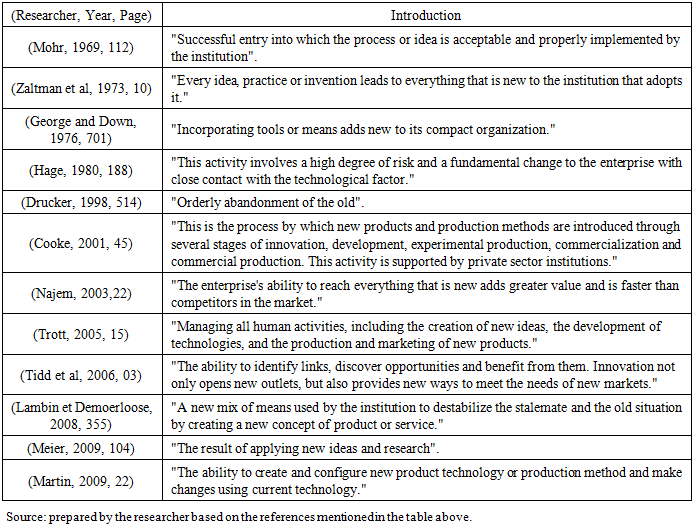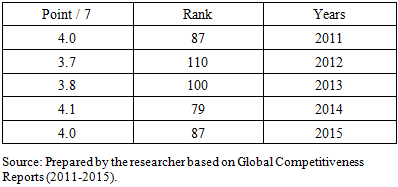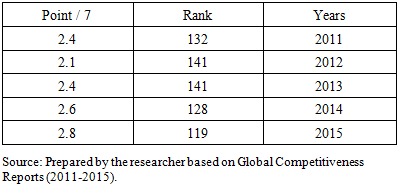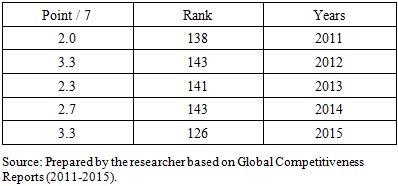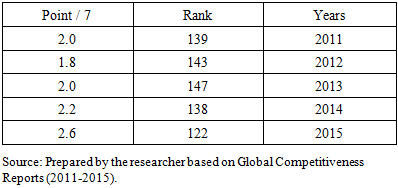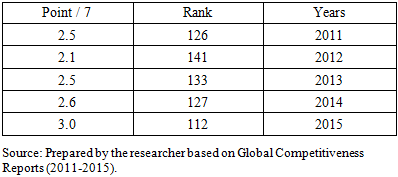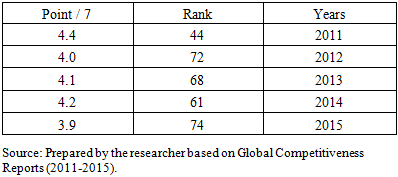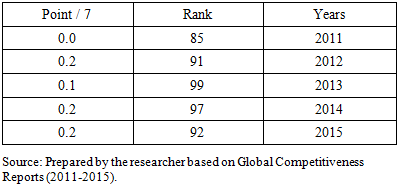-
Paper Information
- Next Paper
- Previous Paper
- Paper Submission
-
Journal Information
- About This Journal
- Editorial Board
- Current Issue
- Archive
- Author Guidelines
- Contact Us
International Journal of Inspiration & Resilience Economy
2020; 4(1): 16-24
doi:10.5923/j.ijire.20200401.03

Reality of Innovation Indicators in Algeria During the Period (2011-2015): An Analytical Study Using the Global Competitiveness Reports (GCR's)
Dr. Aboubaker Khoualed
Faculty of Economic Sciences and Management Sciences, University of Badji Mokhtar, Annaba, Algeria
Correspondence to: Dr. Aboubaker Khoualed , Faculty of Economic Sciences and Management Sciences, University of Badji Mokhtar, Annaba, Algeria.
| Email: |  |
Copyright © 2020 The Author(s). Published by Scientific & Academic Publishing.
This work is licensed under the Creative Commons Attribution International License (CC BY).
http://creativecommons.org/licenses/by/4.0/

This research aims to analyze the reality of innovation in Algeria during the current period, For this reason the researcher used the Global Competitiveness Reports (GCR’s) issued by the World Economic Forum (WEF) during the period (2011-2015) through the study and analysis of the following indicators: capacity for innovation, quality of scientific research institutions, company spending on R and D, university – industry collaboration in R and D, government procurement of advanced technique products, availability of scientists and engineers, PCT patents, At the end the study concluded that there is a weakness of the various innovation indictors in Algeria, In the light of this result the researcher presented a set of recommendations that contribute to encourage the different innovations indicators in Algeria.
Keywords: Innovation, Innovation Indicators, Global Competitiveness Reports (GCR’s), Algeria
Cite this paper: Dr. Aboubaker Khoualed , Reality of Innovation Indicators in Algeria During the Period (2011-2015): An Analytical Study Using the Global Competitiveness Reports (GCR's), International Journal of Inspiration & Resilience Economy, Vol. 4 No. 1, 2020, pp. 16-24. doi: 10.5923/j.ijire.20200401.03.
Article Outline
1. Introduction
- If the 17th-century physicists assert that agriculture is the origin of wealth, the business school advocates of the 18th century assert that trade and precious metals are the ones that generate wealth, and the pioneers of the industrial revolution believe that industry is the source of wealth, Innovation has been seen as an essential tool for generating and sustaining wealth. Innovation has become the fundamental tool for enterprises and nations alike to achieve leadership, growth and competitive advantage in a new, complex and competitive environment.Innovation has become an urgent need for all nations and developed and developing societies alike. In Algeria as well, innovation has become a topic of increasing interest to many parties. Many international and even national reports categorize the indicators of innovation in Algeria with negative or Under zero, despite the great potential of Algeria, which raises a lot of controversy and question marks, and this is what we will try to discuss and analyze through this study, according to the following axes:- Methodology of the study.- Previous studies.- The theoretical framework of the study.- Analytical framework of the study.- Results and recommendations.
2. The Problem of Study
- In recent years, the subject of innovation has attracted the attention of many researchers and scholars. This interest is due to the importance of innovation, which has become the unique strategic weapon that enterprises use to win competitive competition for survival and growth in the market. Innovation is also an effective element in developing States and make further progress in various areas.With the advent of globalization and the expansion of its areas in the world, there have been developments and radical changes in all fields, which has contributed to deepen the gap between developed and developing countries to the extent that it is difficult to reduce them, developed countries have reached the level of access only thanks to the ability to innovation and innovation, Scientific, economic and social problems, while the failure of developing countries resulted from their inability to innovate and innovate, and the inability to bring new to face the various contemporary challenges.In this context, as one of the developing countries, and facing these new challenges, Algeria is forced to work as much as possible to improve its innovative capabilities and to encourage new and innovative ideas. In this context, we are currently questioning the reality of innovation indicators in Algeria during the current period and the classification it has achieved. Specialized international reports, which will form the focus of this study.
2.1. Hypotheses of the Study
- Based on the study problem, the following hypotheses were formulated:First Hypothesis: Innovation plays a big role in the success and sustainability of institutions and the progress and development of countries and societies.Second Hypothesis: Algeria's indicators of innovation are very positive according to the Global Competitiveness Reports (GSR's) during the period (2011-2015).
2.2. The Study Model
- In order to facilitate the process of answering the problem of the study and verifying its various hypotheses, the researcher developed a model for his study, as illustrated in Figure (1).
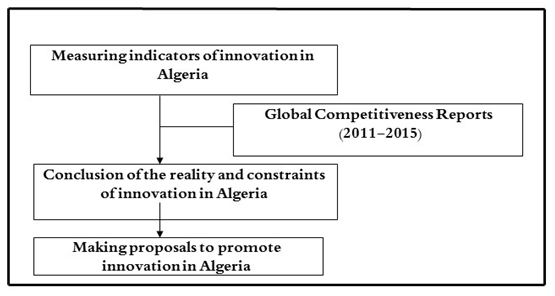 | Figure (1). The Framework of the Study (Source: Prepared by the researcher.) |
2.3. Importance of the Study
- The importance of this study stems from the importance of the subject of innovation itself as one of the modern topics in contemporary administrative literature, both in terms of economic theory and intellectual and methodological frameworks, or at the level of practical applications. The importance of this study stems from the importance of the role played by innovation in institutions and countries alike, where it maximizes value and contributes to innovation and innovation, thereby building sustainable competitive advantages.The study also draws on the paucity of research and studies at the national level in this field. This study will pave the way for subsequent studies and open new research avenues on this vital subject.
2.4. The Objectives of the Study
- This study aims to achieve the following set of objectives:4.1 To highlight the growing importance of innovation at the institutional and State level.4.2 To identify the reality of innovation in Algeria during the current period.4.3 Identify the most important obstacles to innovation in Algeria and draw the most prominent proposals to promote it.4.4 Trying to raise awareness among decision-makers of the importance and feasibility of innovation in driving development in Algeria.
3. Methodology
- In our study of this subject, we relied on the analytical descriptive approach by studying and taking note of various aspects of the subject by collecting and analyzing data and information, and extracting the most prominent results.In order to prepare this research, the theoretical aspect of the desk survey was based on reference to the various references and previous studies available in Arabic, English and French from books, periodicals, memoirs, etc., and on the analytical side, it relied mainly on a set of indicators of innovation and derived from the Global Competitiveness Reports during the period (2011-2015). It was also adopted to a lesser extent on a set of statistics obtained by the researcher from several local and international reports and websites that serve the studied topic.
4. Literature Review
4.1. Previous Studies and the Characteristics of the Current Study
- The researcher has conducted a survey of the various researches and studies on the subject of innovation in Algeria. If we exclude research and studies that have dropped the subject of innovation on different Algerian institutions, we receive very few studies that dealt with the issue of innovation indicators in Algeria at the macro level. The most prominent and recent of these studies:
4.1.1. Study of (Al-Zoubi, 2011)
- The objective of this study is to identify the most important factors affecting innovation as a leading input in the knowledge economy. In order to achieve the above objective, this study came in the form of a comparative study between Algeria and Jordan. The researcher collected a set of data related to the two countries' (2010), it was later used to construct a standard model of 16 variables in the innovation activity of the two countries. After the analysis, the results showed that there is one factor, the expenditure on innovation, which has the greatest impact on innovation activity in both countries.
4.1.2. Study of (Duis and Bekhty, 2012)
- This study mainly sought to assess the process of innovation in Algeria during the period (1996-2007). In order to achieve the above objective, the researchers studied the patent data registered with the INAPI in two phases. The first phase, The invention was granted to Algerians during the period (1996-2007) and then analyzed statistically, and the second stage in which the researchers classified patents according to the International Patent Classification (IPC) code (2010.01) prepared by the International Intellectual Property Organization (OMPI). The results revealed that mostInnovations in Algeria are carried out by individuals (76.90%), followed by private and public institutions (23.10%). This gives a clear idea of the quality of the innovations in Algeria and the means of financing them. This has made a large part of these innovations find their way to industry, In most developed countries according to researchers.
4.1.3. Study of (Boumediene and Chitwan, 2014)
- The objective of this study is to analyze the innovation policy in Algeria and its indicators, and to highlight the extent to which the innovation policy can be relied upon to promote Algerian exports outside the hydrocarbons sector. To achieve the above objective, the researchers relied on the analytical descriptive approach by analyzing the impact of innovation on the growth of Algerian exports outside the hydrocarbons sector Two main indicators: the number of patents and R & D expenditures. Finally, the researchers found a number of results, notably the absence of a clear national strategy for innovation development in Algeria, which resulted in the non-activation of a national system of innovation Thus dedicating the dominance of the hydrocarbon sector on the Algerian exports.
4.1.4. Study of (Lahmer, 2015)
- The objective of this study was to analyze the readiness of the Algerian economy to integrate into the knowledge economy. To achieve the above objective, the researcher adopted the comparative analytical descriptive method by analyzing a set of data on the indicators of knowledge economy (ICT index, education index, innovation index, (2003-2013) based on the World Bank methodology (WB). After the analysis and comparison process, the results showed that Algeria is still far from the knowledge economy due to several shortcomings Zaha structural imbalance of the economy and the knowledge gap, however, Algeria is pursuing long-term strategies for the development of knowledge with a focus on achieving real growth rates according to the researcher.The current study is distinguished from previous studies in terms of their analytical framework, which is based on a set of the latest WEF data and statistics in the Global Competitiveness Reports (2011-2015). The Global Competitiveness Reports are effective indicators for measuring capacity and tools to examine the strengths and weaknesses of business data. It is also a tool for guiding the economic policies of different countries. As for the innovation sub-index, which is based on this study and published in the Global Competitiveness Reports, Credibility to express the real situation of innovation in different countries and nations as to take into account all the variables denominated innovation activity at the level of these countries.
4.2. The Theoretical Framework of the Study
4.2.1. The Concept of Innovation and Its Characteristics
- The concept of innovation has attracted the attention of many writers of management and economics in recent years, and this attention is undoubtedly due to the importance of innovation as a complex, multi-dimensional, multidimensional phenomenon affecting all fields. (Abu al-Nasr, 2002, 90)Innovation is a Latin word composed of the terms "In" and "novare" which means "putting something new and different". (Bessant, 2009, 06)The concept of innovation as a modern term is attributed to the Austrian economist Joseph Schumpeter (1912), who first defined innovation as "the result of the creation of a new method or method of production that changes all components of the product or how it is designed”. (Lachman, 1993, 15)The definitions of innovation varied and the views differed in the definition of what it was because of the different views and areas of interest of researchers and specialists. However, the most prominent definitions of the concept of innovation can be presented in Table (1) below:
|
4.2.2. The Importance of Innovation
- Innovation has become a standard in light of the degree of progress and progress of nations. It has become seen as a source of wealth and an important factor in advancing economic and social development. Innovation has become an important indicator, which helps to a large extent to infer the progress of institutions and States Both. (Al-Sirafi, 2003, 38)Porter emphasized that institutions can achieve competitive advantage through innovation. Furthermore, Schermerhorn emphasizes in his book "Events" that: Innovation is a competitive advantage. (Star, 2003, 20). In general, the importance of innovation can be summarized in the following points: (Mustafa, 2002, 260) (Sulaimani, 2007, 36).- Develops and supervises personal skills in thinking and collective interaction through brainstorming teams.- Increase the quality of decisions in various technical, financial and marketing fields.- Improves product quality, helps to find ways to activate and increase sales volume.- Helps to create and strengthen the competitiveness of enterprises and nations.- Has a major role in industrial development is the main engine of growth and development in both developed and developing countries.
5. Analytical Framework of the Study
- The Global Competitiveness Reports measure factors that drive the prosperity and productivity of more than 140 countries around the world and rely on three key indicators to measure the country's global competitiveness:- The basic requirements of the economy.- Improved economic efficiency factors.- Factors of creativity and evolution.These include: infrastructure, macroeconomic environment, health and basic education, university education and training, efficiency of commodity markets, labor market efficiency, capital market development, technological readiness, market size, business development, Innovation.The Global Competitiveness Reports are reports issued by the World Economic Forum (WEF) annually since 2004. These reports are an important economic reference for business, institutions and countries alike in shaping their economic policies and seeking to improve their competitiveness.Algeria ranked 87th in the latest Global Competitiveness Report issued by the World Economic Forum for 2015 out of 148 countries covered by the report. Algeria scored 4 out of 7 points, Algeria has been in the last five years in table (2) below:
|
|
|
|
|
|
|
|
|
6. Conclusions and Recommendations
6.1. The Results of the Study
6.1.1. The Results of the Theoretical Study
- Based on what was addressed in the theoretical framework of this study has been reached the following results:- Despite the differences of studies and research and disagreement on the concept of innovation, but they all agree on the importance of integration in institutions and States alike.- The concept of innovation refers to the set of scientific, technical, commercial and financial steps necessary for the success and development of new or improved products, the commercial use of methods, processes and equipment, the introduction of a new method of service or the manner in which it is performed.Innovation should be characterized by four basic characteristics: differentiation, innovation, ability to discover opportunities, and first market action. Innovation is of paramount importance to both institutions and countries: Improve the quality of products, and help to find ways to activate and increase the volume of sales, increasing the quality of decisions in various areas of technical, financial and marketing, enhances the competitiveness of the institution.Innovation is the main engine of growth and development in developed and developing countries. Based on the findings, the first hypothesis that "innovation plays a major role in the success and sustainability of institutions and the progress and development of countries and societies" has been validated.
6.1.2. Results of the Analytical Study
- The analytical framework of this study has been discussed and analyzed in various countries in the field of innovation according to the global competitiveness reports during the period (2011-2015), where Algeria obtained results that were generally very weak in the various seven sub - indices Innovation, spending on research and development activities, quality of scientific research institutions, cooperation between universities and institutions, government exports of high-tech products, availability of scientists and engineers, and patents. This negates the second hypothesis that " Indicators achieved by Algeria in the field of innovation is very positive, according to the Global Competitiveness reports during the period (2011-2015). "
6.2. Recommendations of the Study
- Based on the results reached by the researcher in the latter to provide a set of suggestions and solutions that, if applied, can help Algeria in the activation of innovative policies, notably:- The need to pay more attention to the issue of innovation in Algeria through the development of effective policies and strategies for innovation and work on the development of axes to implement them.- Direct innovation and R & D activities towards important strategic sectors.- Seeking appropriate ways and mechanisms to finance various innovative activities and research and development activities while seeking to increase the contribution of the private sector in this field.- Increasing the quality of education and training and activating them, and supporting human capabilities especially special and innovative.- To raise awareness and awareness of the importance of innovation and invention activities at all levels (schools, institutes, universities, ... etc).- Make greater efforts and provide all the requirements and conditions suitable for the return of scientific competencies migrating.- Studying the various leading international experiences in the field of innovation carefully and identifying ways and means of adapting and benefiting from them.Finally, it should be noted that the problem of this study does not end here, but is enriched by several other aspects through future research aimed at several aspects and other issues related to innovation in Algeria.
 Abstract
Abstract Reference
Reference Full-Text PDF
Full-Text PDF Full-text HTML
Full-text HTML